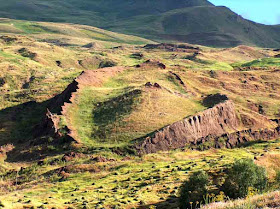Among all the landscapes in Colombia, Tatacoa Desert is most impressive, due to its greatness, its natural rarity, and its peculiarity. A 330 Square Kilometers desert is a second largest arid zone in Colombia after the Guajira Peninsula. The desert is located north of Huila Department, 38 KM from City of Neiva and 15 KM from Natagaima in Tolima. This semiarid region is a rich deposit of fossils and has two distinctive colors, other in the area of Cuzco and gray in the Los Hoyos area. The Tatacoa Desert is one of the few places on the earth, where the sky always seems majestic. In the desert, you can expect blue skies during the day and endless constellations at night.
Tatacoa Desert Landscape
The Tatacoa Desert or the Valley of Sorrows is not just a desert, but a tropical dry forest. Tatacoa is a Spanish name, meaning rattlesnakes. During the Tertiary Period, it was much wetter, with thousands of rare flowers and trees, but as time passes, it has been gradually drying up to become a desert. The Tatacoa is heavily eroded and crossed by dry canyons that develop transiently in the winter months or during the rainy seasons.
The exclusive secretive shapes are created on clay surfaces, creating labyrinthine gullies in the landscape that can reach 20 meters deep. The Tatacoa Desert is one of the amazing landscapes, geographical wonders, and a magic sky. The desert average temperature is 28° C; yet on sunny days, it can go up to 40° C. For these reasons, the Tatacoa Desert receives many visits of paleontologists and geologists for whom it is a research paradise.
Fauna and Flora in Tatacoa Desert
In the low humidity and high temperatures, there is relatively little runoff, and animal and plant life is adapted to the conditions. The plants in this area are adapted to climatic conditions through the development of horizontal roots. The wildlife includes rodents, turtles, spider, snakes, spiders, scorpions, eagles, alligators and wildcats, and cacti reaching between four and five meters high.
Great Tourist Destination
Tatacoa Desert atmospheric conditions are good for astronomy and many extraordinary natural destinations of Colombia. The area has little pollution or noise, attracting tourists who stay there to enjoy the silence, scenery and tranquility or the stressful city noises. Although it is not necessary to go into the observatory for stargazing, as the desert is a place with a privileged and clear view of the sky, as there is no light pollution.
The most important thing is your health in a desert environment. So bring plentiful water as you could get lost, get sunstroke or dehydrate. So, to make your experience safer it is the main key. Tatacoa Desert is one of the most iconic places in Colombia. Despite the particular geographical conditions, a cavernous desert, difficult climatic conditions has become one of the most popular tourist destinations in the country. A good reason to be here, The National Bambuco Pageant is the Tatacoa Star Party 2009, which will take place in the desert between June 17 and 20, 2009. Source: CP
Things to Do in Tatacoa Desert
Here are some of the interesting activities that may entice you whilst at Desierto de la Tatacoa.
· Rent a Bike
· Horse Riding
· Fauna and Flora
· Hiking with a local guide
· Swimming


































































